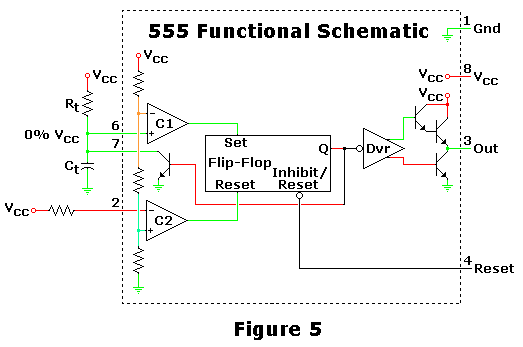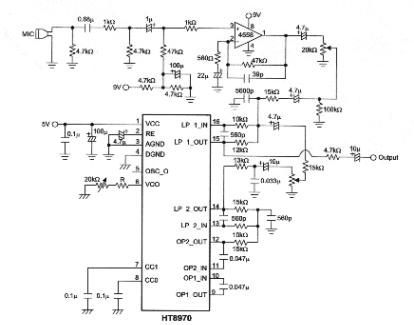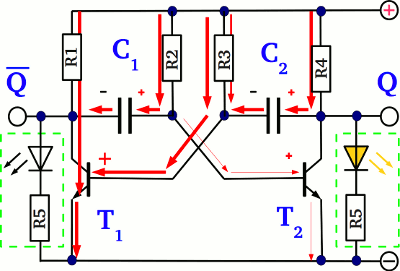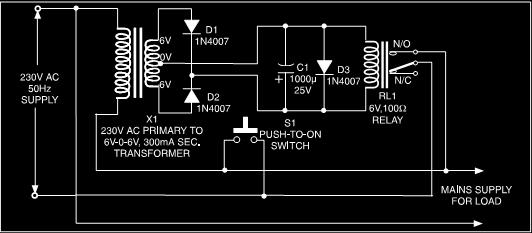
Fundamentals of Electrical Engineering and Monostable Multivibrator

This is one of the most basic 555 circuits. This circuit is part of the chip's datasheet, complete with the math needed to design to specification, and is one of the reasons a 555 is referred to as a timer. The green LED shown in the illustration lights up when the 555 output is high (i.e., switched to Vcc), and the red LED lights up when the 555 output is low (switched to ground). This particular monostable multivibrator (also known as a monostable or timer) is not a retriggerable type. This means once triggered, it will ignore further inputs during a timing cycle, with one exception, which will be discussed in the next paragraph. The timer starts when the input goes low, or is switched to the ground level, and the output goes high. It can be demonstrated by connecting the red wire shown in the illustration between ground and point B, disconnecting it, and reconnecting it. It is an illegal condition for the input to stay low for this design past the timeout. For this reason, R3 and C1 were added to create a signal conditioner, which will allow edge-only triggering and prevent the illegal input. It can be proven by connecting the red wire between ground and point A. The timer will start when the wire is inserted into the protoboard between these two points and will ignore further contacts. If the timer input is forced to stay low past the timeout, the output will remain high, even though the timer has finished. As soon as this ground is removed, the timer will go low. Rt and Ct were selected for a 3-second timing duration. This can be verified with a watch; 3 seconds is long enough for a human to measure it. Swapping Rt and Ct with a 27 kΩ resistor and a 100 µF capacitor should yield no difference in operation, as the answer to the formula remains the same. Next, swapping Rt with a 270 kΩ resistor will result in a time constant that is approximately 10 times greater, yielding close to 30 seconds. The resistor and capacitor typically have tolerances of 5% and 20%, respectively, so the measured times may vary up to 25%, although they will usually be much closer. Another advantageous feature of the 555 is its immunity to power supply voltage variations. Replacing the 9V battery with a 6V or 12V battery should yield identical results, although the LED light intensity may change. C2 is not strictly necessary; the 555 IC includes this option in case the timer is used in environments where the power supply line is noisy. It can be removed without noticeable difference. The 555 itself can generate noise, as there is a very brief period when the transistors on both sides of the output are conducting, creating a power surge (measured in nanoseconds) from the power supply. The transistor functions as a switch that normally conducts until pin 2 (connected through comparator C1, which feeds the internal flip-flop) is brought low, allowing capacitor Ct to begin charging. Pin 7 remains off until the voltage on Ct charges to 2/3 of the power supply voltage, at which point the timer times out, and pin 7's transistor turns on again, returning to its normal state in this circuit. The circuit's operation can be visualized, with red indicating higher voltages and green indicating ground (0 volts), illustrating the spectrum in between, as this is fundamentally an analog circuit. The starting and ending point for this circuit is where it awaits a trigger to initiate a timing cycle. At this point, the pin 7 transistor is on, keeping capacitor Ct discharged. The circuit can also be observed in the process of switching off when it reaches timeout. The capacitor has charged to 67%, the upper limit of the 555 circuit, causing its internal flip-flop to switch states. As illustrated, the transistor has not yet switched, which will discharge Ct once it does.
The 555 timer IC is a versatile component widely used in various timing applications. In this monostable configuration, the circuit is designed to produce a single output pulse of a defined duration in response to a trigger input. The timing period is primarily determined by the resistor (Rt) and capacitor (Ct) values connected to the 555 timer. The relationship between these components is governed by the formula T = 1.1 * Rt * Ct, where T is the timing interval in seconds.
In practical applications, the circuit can be used in various scenarios, including generating time delays, pulse-width modulation, or as a simple timer for applications such as automatic lights or sound effects in toys. The choice of components significantly influences the performance and stability of the circuit. For instance, using high-quality capacitors with low leakage and precision resistors can enhance timing accuracy, which is crucial in applications where timing is critical.
In addition, the design incorporates a signal conditioning stage with R3 and C1 to ensure that the input signal is clean and free of noise that could cause false triggering. This is particularly important in environments with electrical interference, which could otherwise lead to erratic behavior of the circuit.
The 555 timer's ability to operate across a wide voltage range allows for flexibility in power supply choices, making it suitable for battery-operated devices as well as those powered by standard AC adapters. The inclusion of C2, although not essential, provides an additional layer of noise filtering, which can be beneficial in sensitive applications.
Overall, the 555 timer in this monostable configuration exemplifies a fundamental yet powerful electronic circuit, demonstrating the principles of timing and signal conditioning, and serves as an excellent introduction to timer circuits for both educational and practical purposes.This is one of the most basic 555 circuits. This circuit is part of this chips datasheet, complete with the math needed to design to specification, and is one of the reasons a 555 is referred to as a timer. The green LED shown on the illustration lights when the 555 output is high (i. e. , switched to Vcc), and the red LED lights when the 555 output is low (switched to ground). This particular monostable multivibrator (also known as a monostable or timer) is not a retriggerable type. This means once triggered it will ignore further inputs during a timing cycle, with one exception, which will be discussed in the next paragraph.
The timer starts when the input goes low, or switched to the ground level, and the output goes high. You can prove this by connecting the red wire shown on the illustration between ground and point B, disconnecting it, and reconnecting it. It is an illegal condition for the input to stay low for this design past timeout. For this reason R3 and C1 were added to create a signal conditioner, which will allow edge only triggering and prevent the illegal input.
You can prove this by connecting the red wire between ground and point A. The timer will start when the wire is inserted into the protoboard between these two points, and ignore further contacts. If you force the timer input to stay low past timeout the output will stay high, even though the timer has finished.
As soon as this ground is removed the timer will go low. Rt and Ct were selected for 3 seconds timing duration. You can verify this with a watch, 3 seconds is long enough that we slow humans can actually measure it. Try swapping Rt and Ct with the 27 KO resistor and the 100 µF capacitor. Since the answer to the formula is the same there should be no difference in how it operates. Next try swapping Rt with the 270 KO resistor, since the RC time constant is now 10 times greater you should get close to 30 seconds.
The resistor and capacitor are probably 5% and 20% tolerance respectively, so the calculated times you measure can vary as much as 25%, though it will usually be much closer. Another nice feature of the 555 is its immunity from the power supply voltage. If you were to swap the 9V battery with a 6V or 12 battery you should get identical results, though the LED light intensity will change.
C2 isn`t actually necessary. The 555 IC has this option in case the timer is being used in an environment where the power supply line is noisy. You can remove it and not notice a difference. The 555 itself is a source of noise, since there is a very brief period of time that the transistors on both sides of the output are both conducting, creating a power surge (measured in nanoseconds) from the power supply.
This transistor is simply a switch that normally conducts until pin 2 (which is connected through the comparator C1, which feeds the internal flip flop) is brought low, allowing the capacitor Ct to start charging. Pin 7 stays off until the voltage on Ct charges to 2/3 of the power supply voltage, where the timer times out and pin 7 transistor turns on again, its normal state in this circuit.
) will show the sequence of switching, with red being the higher voltages and green being ground (0 volts), with the spectrum in between since this is fundamentally an analog circuit. is the starting and ending point for this circuit, where it is waiting for a trigger to start a timing cycle.
At this point the pin 7 transistor is on, keeping the capacitor Ct discharged. shows the circuit in the middle of switching off when it hits timeout. The capacitor has charged to 67%, the upper limit of the 555 circuit, causing its internal flip flop to switch states. As shown, the transistor hasn`t switched yet, which will discharge Ct when it does. 🔗 External reference
The 555 timer IC is a versatile component widely used in various timing applications. In this monostable configuration, the circuit is designed to produce a single output pulse of a defined duration in response to a trigger input. The timing period is primarily determined by the resistor (Rt) and capacitor (Ct) values connected to the 555 timer. The relationship between these components is governed by the formula T = 1.1 * Rt * Ct, where T is the timing interval in seconds.
In practical applications, the circuit can be used in various scenarios, including generating time delays, pulse-width modulation, or as a simple timer for applications such as automatic lights or sound effects in toys. The choice of components significantly influences the performance and stability of the circuit. For instance, using high-quality capacitors with low leakage and precision resistors can enhance timing accuracy, which is crucial in applications where timing is critical.
In addition, the design incorporates a signal conditioning stage with R3 and C1 to ensure that the input signal is clean and free of noise that could cause false triggering. This is particularly important in environments with electrical interference, which could otherwise lead to erratic behavior of the circuit.
The 555 timer's ability to operate across a wide voltage range allows for flexibility in power supply choices, making it suitable for battery-operated devices as well as those powered by standard AC adapters. The inclusion of C2, although not essential, provides an additional layer of noise filtering, which can be beneficial in sensitive applications.
Overall, the 555 timer in this monostable configuration exemplifies a fundamental yet powerful electronic circuit, demonstrating the principles of timing and signal conditioning, and serves as an excellent introduction to timer circuits for both educational and practical purposes.This is one of the most basic 555 circuits. This circuit is part of this chips datasheet, complete with the math needed to design to specification, and is one of the reasons a 555 is referred to as a timer. The green LED shown on the illustration lights when the 555 output is high (i. e. , switched to Vcc), and the red LED lights when the 555 output is low (switched to ground). This particular monostable multivibrator (also known as a monostable or timer) is not a retriggerable type. This means once triggered it will ignore further inputs during a timing cycle, with one exception, which will be discussed in the next paragraph.
The timer starts when the input goes low, or switched to the ground level, and the output goes high. You can prove this by connecting the red wire shown on the illustration between ground and point B, disconnecting it, and reconnecting it. It is an illegal condition for the input to stay low for this design past timeout. For this reason R3 and C1 were added to create a signal conditioner, which will allow edge only triggering and prevent the illegal input.
You can prove this by connecting the red wire between ground and point A. The timer will start when the wire is inserted into the protoboard between these two points, and ignore further contacts. If you force the timer input to stay low past timeout the output will stay high, even though the timer has finished.
As soon as this ground is removed the timer will go low. Rt and Ct were selected for 3 seconds timing duration. You can verify this with a watch, 3 seconds is long enough that we slow humans can actually measure it. Try swapping Rt and Ct with the 27 KO resistor and the 100 µF capacitor. Since the answer to the formula is the same there should be no difference in how it operates. Next try swapping Rt with the 270 KO resistor, since the RC time constant is now 10 times greater you should get close to 30 seconds.
The resistor and capacitor are probably 5% and 20% tolerance respectively, so the calculated times you measure can vary as much as 25%, though it will usually be much closer. Another nice feature of the 555 is its immunity from the power supply voltage. If you were to swap the 9V battery with a 6V or 12 battery you should get identical results, though the LED light intensity will change.
C2 isn`t actually necessary. The 555 IC has this option in case the timer is being used in an environment where the power supply line is noisy. You can remove it and not notice a difference. The 555 itself is a source of noise, since there is a very brief period of time that the transistors on both sides of the output are both conducting, creating a power surge (measured in nanoseconds) from the power supply.
This transistor is simply a switch that normally conducts until pin 2 (which is connected through the comparator C1, which feeds the internal flip flop) is brought low, allowing the capacitor Ct to start charging. Pin 7 stays off until the voltage on Ct charges to 2/3 of the power supply voltage, where the timer times out and pin 7 transistor turns on again, its normal state in this circuit.
) will show the sequence of switching, with red being the higher voltages and green being ground (0 volts), with the spectrum in between since this is fundamentally an analog circuit. is the starting and ending point for this circuit, where it is waiting for a trigger to start a timing cycle.
At this point the pin 7 transistor is on, keeping the capacitor Ct discharged. shows the circuit in the middle of switching off when it hits timeout. The capacitor has charged to 67%, the upper limit of the 555 circuit, causing its internal flip flop to switch states. As shown, the transistor hasn`t switched yet, which will discharge Ct when it does. 🔗 External reference





